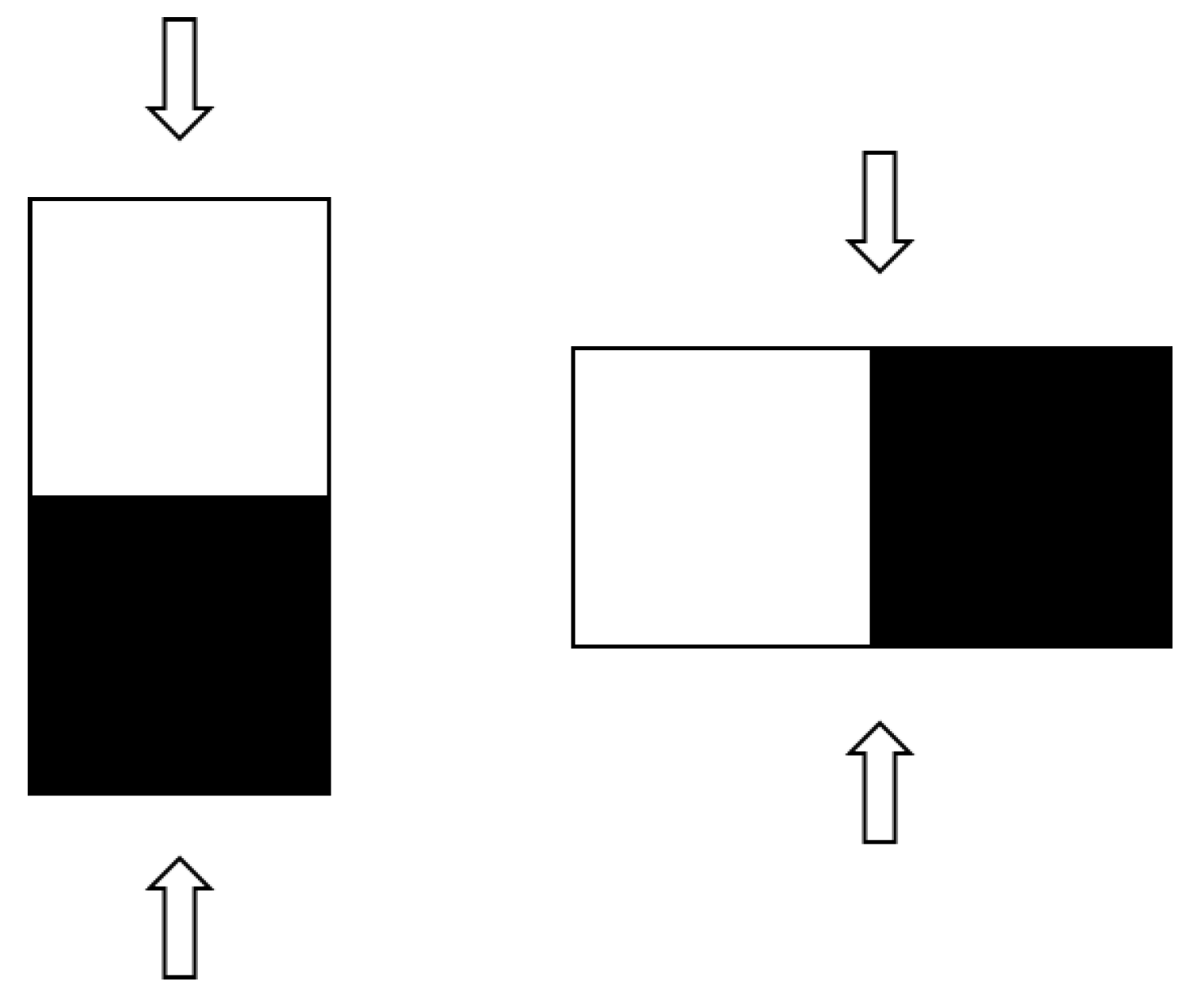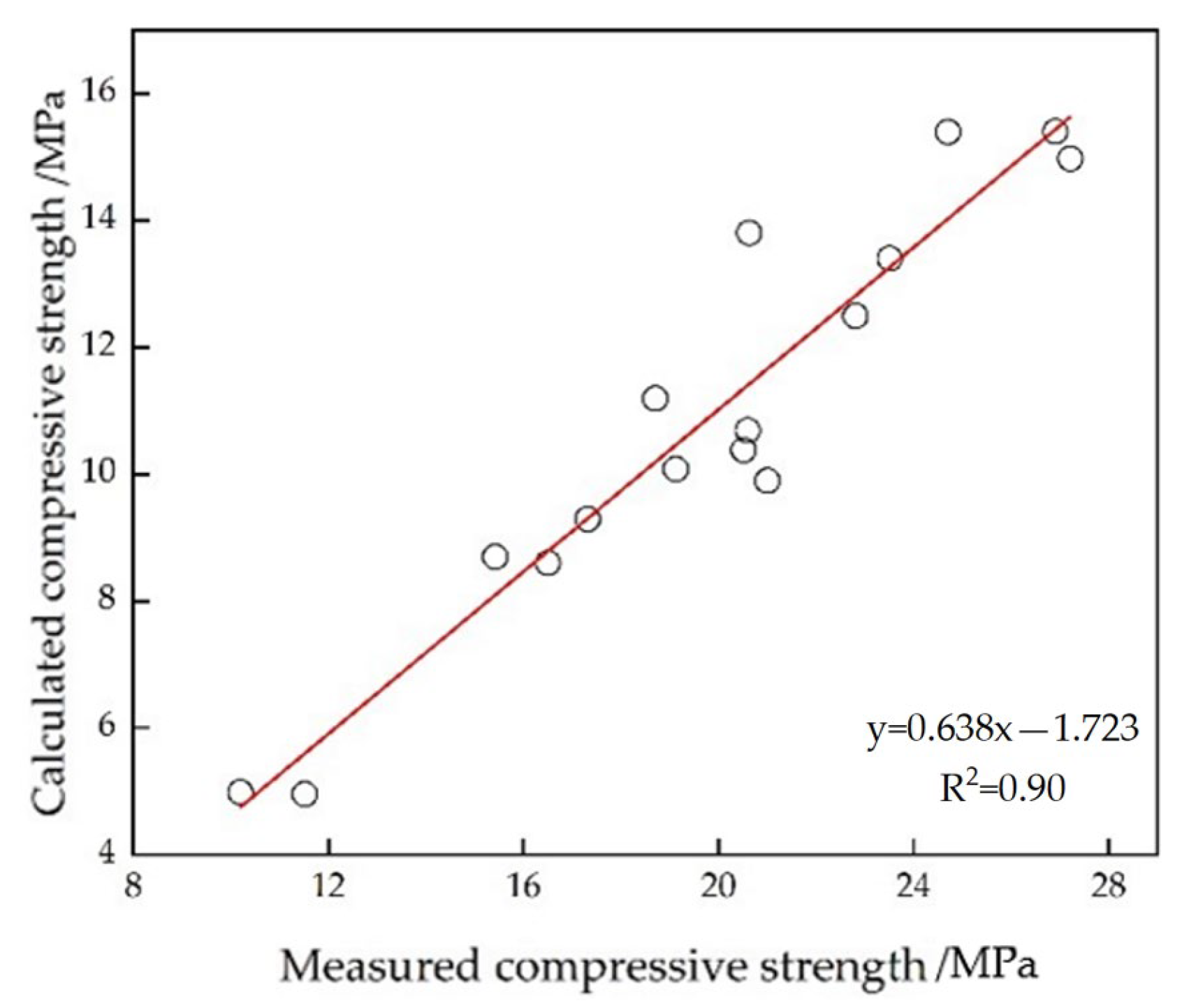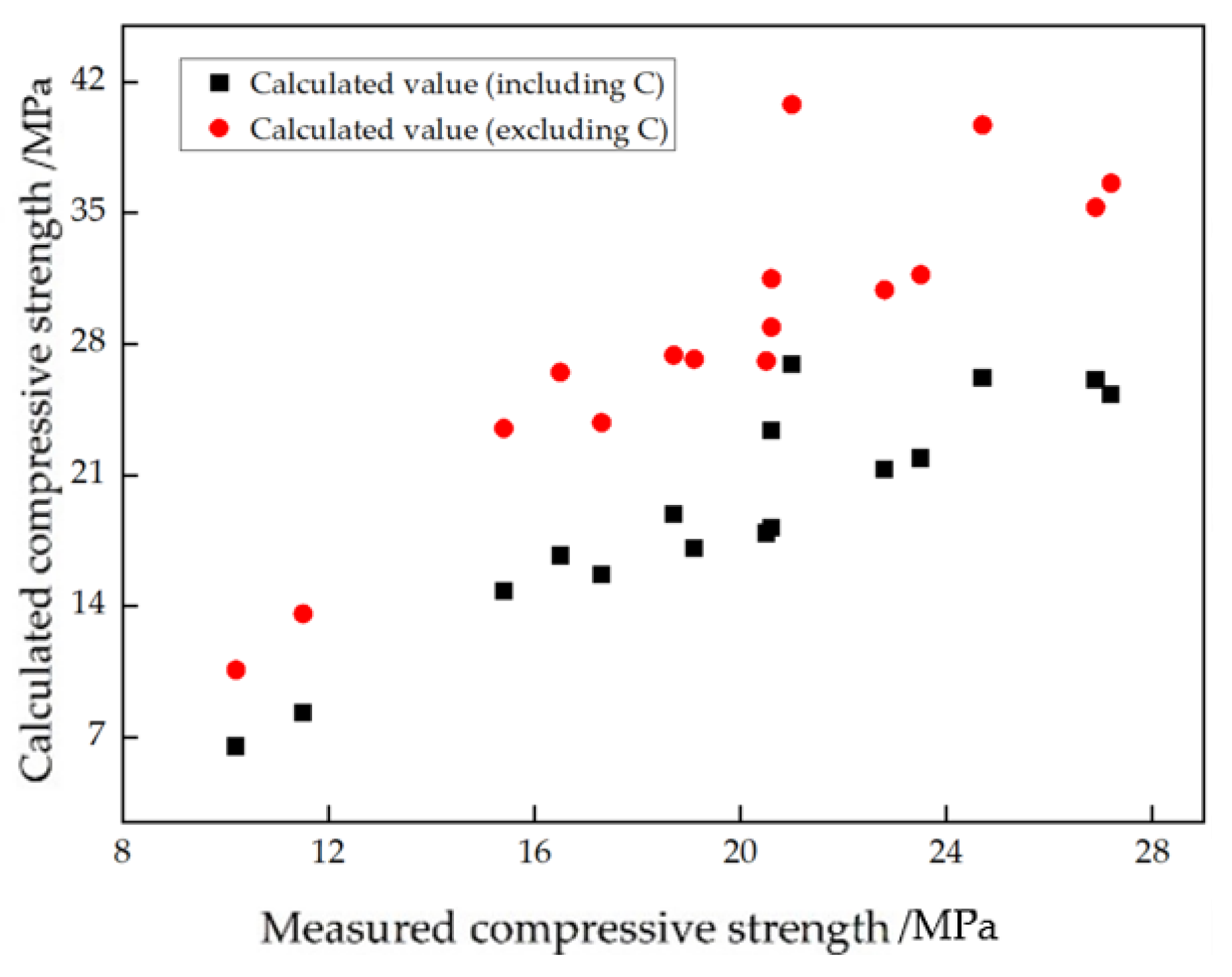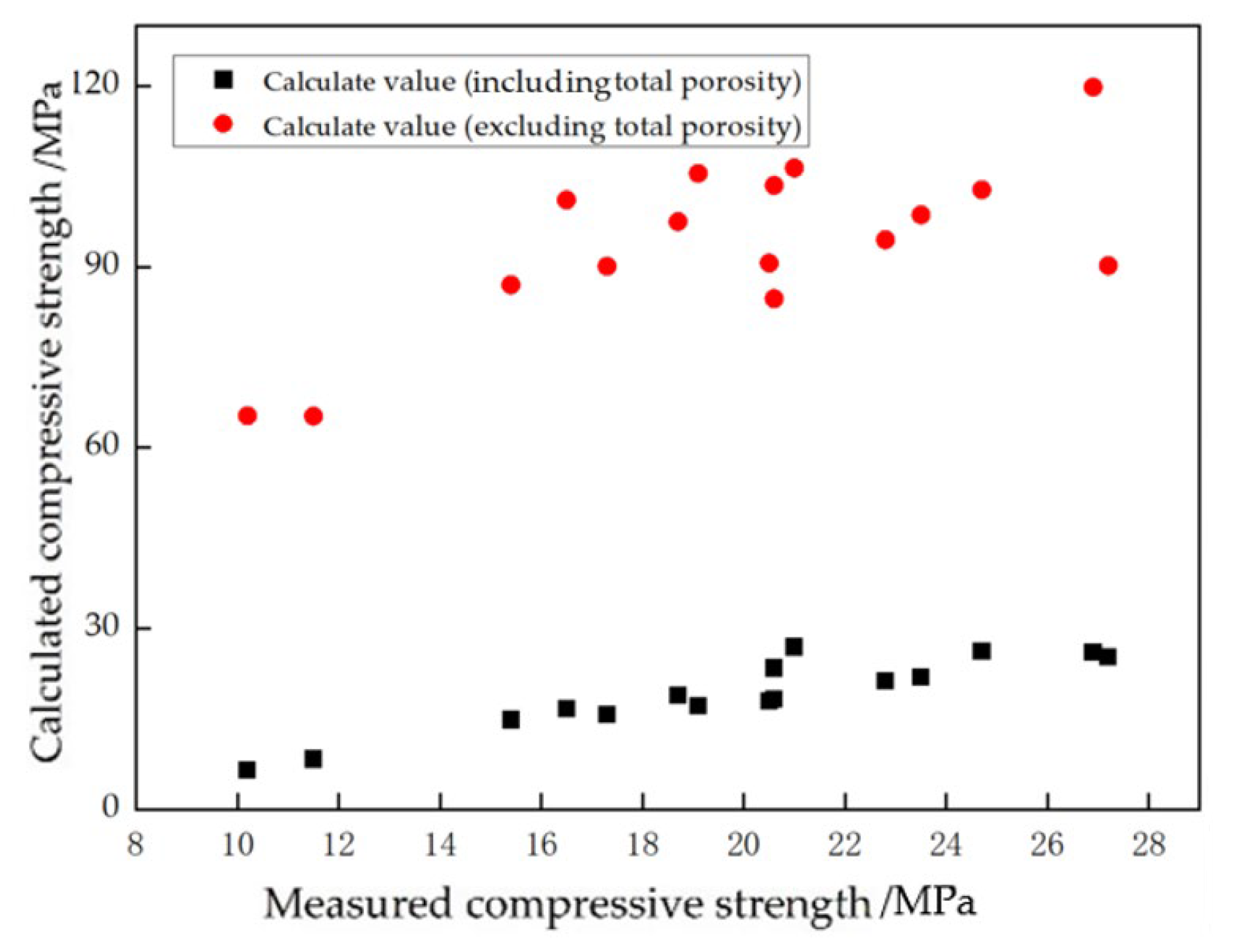Research on the Relationship between Pore Structure and the Compressive Strength of Oil-Well Cement
Abstract
:1. Introduction
2. Description of the Experiment
2.1. Experimental Reference Standard
2.2. Cement Sample Preparation
3. Modification of Fracture Theory
4. Establishment of the Model between Pore Structure and Strength
4.1. Establishment of the Pore Structure Model
- The percentage of pore volume occupied by pores with different pore diameters of cement is equal to the percentage of fractional porosity of the pore to the total porosity, which is expressed as fi:
- 2.
- According to the analysis conclusion in the previous section, the formula for calculating the critical stress when the cement is fractured in tension is as follows:
- 3.
- Assuming that the failure of cement occurs first at the weakest cross-section, the average stress σ on the section at this time is
4.2. Establishment of the Physical Model of Pore Structure
5. Failure and Qualitative Analysis of the Pore Structure Model
5.1. Failure Process Analysis of the Pore Structure Model
5.2. Qualitative Analysis of the Cement’s Pore Structure Model
- Oil-well cement includes a solid matrix and a pore structure. The strength of the solid-phase matrix of cement is affected by its gel components. For cement with the same matrix, if the porosity is large, the net cross-sectional area per unit section will be small. The greater the compressive stress, the lower the load at the time of failure of the cement structure, and the lower the calculated compressive strength of the cement.
- If the matrix strength and total porosity of the cement are the same, according to the above cycle process, the more large pores per unit area, the faster the decrease in the net cross-sectional area, the smaller the load during the cement structure failure, and the lower the compressive strength. Thus, under the same porosity, the effect of large pores on strength is more unfavorable than that of small pores.
- Porosity is not the only parameter used to measure the compressive strength of cement. The pore size distribution also affects the compressive strength. If the influence of pore structure distribution is considered, the compressive strength of cement with a small porosity may be lower than that of cement with a large porosity, that is, the porosity is small but the distribution of macropores is large., and the porosity is large but the distribution of macropores is small.
- The strength of the cement matrix is related to the content of the cementitious components in unit volume. According to a previous analysis, this condition is related to the connection between the cement particles and the van der Waals force between the hydration products. The content of cementitious components per unit volume is related to the content of oil-well cement.
- The strength of the cement matrix is related to the cement content. The higher the cement content per unit volume, the higher the cementitious component, and the higher the matrix strength. Water content is proportional to the porosity of the cement.
6. Compilation and Parameter Analysis of the Relationship Model between Pore Structure and Strength
6.1. Compilation of the Relationship Model between Pore Structure and Strength
6.2. Regression Analysis of Constant K
- The range of K values was preliminarily determined through trial calculation;
- The calculation was carried out through interpolation to obtain a relatively accurate K value, and then the value was substituted into the strength model for verification;
- If the calculated intensity error of the obtained K value was large, the calculation was repeated until the result became close to the measured value.
6.3. Analysis of the Influence of Cement Content on the Model
6.4. Analysis of the Influence of Total Porosity on the Model
7. Conclusions
- Class G cement is composed of a cement matrix and pore structure. Through the analysis of its failure process, it can be concluded that when the strength of the cement matrix and the pore size distribution characteristics are the same, the smaller the porosity is, the higher the compressive strength of the cement specimen is.
- The cement with the same formula and porosity as Class G oil well, if containing more large pores, leads to a faster reduction in the effective cross-sectional area of loaded units and a smaller load at which the cement fails. Therefore, the compressive strength of cement specimens is lower. This also indicates that porosity alone cannot fully describe the pore structure characteristics of cement, and the existence of large pores has a more adverse effect on compressive strength than small pores with the same volume.
- The porosity of cement is not the only structural parameter affecting compressive strength. The size distribution of pores has a significant impact on the strength of cement. For example, a cement specimen with low porosity may have lower compressive strength than a specimen with relatively high porosity if it contains a certain amount of large pores, provided that the specimen with higher porosity has uniformly distributed small pores.
- Through the above analysis, the structural model of cement considers the influence of factors such as cement content, the elastic modulus of cement, fracture surface energy, and pore distribution. The establishment process is reasonable. Via regression analysis, taking the K value as 1600, the correlation coefficient between the calculated values of the model and experimental measurements was 1.077.
Author Contributions
Funding
Data Availability Statement
Conflicts of Interest
References
- Niu, Q.H.; Cao, L.W.; Sang, S.X.; Wang, W.; Yuan, W.; Chang, J.F.; Jia, X.-J.; Zheng, W.-M.; Zhang, Z.X. A small-scale experimental study of CO2 enhanced injectivity methods of the high-rank coal. Pet. Sci. 2021, 18, 1427–1440. [Google Scholar] [CrossRef]
- Li, H.B.; Yang, Z.M.; Li, R.S.; Zhou, T.Y.; Guo, H.K.; Liu, X.W.; Dai, Y.-X.; Hu, Z.-G.; Meng, H. Mechanism of CO2 enhanced oil recovery in shale reservoirs. Pet. Sci. 2021, 18, 1788–1796. [Google Scholar] [CrossRef]
- Griffith, A.A. The Phenomena of Rupture and Flow in Solids. Philos. Trans. R. Soc. A Math. Phys. Eng. Sci. 1920, 221, 163–198. [Google Scholar] [CrossRef] [Green Version]
- Walton, J.; Button, C.E. Towards carbon neutrality and environmental sustainability at CCSU. Int. J. Sustain. High. Educ. 2009, 10, 279–286. [Google Scholar] [CrossRef]
- Jian, S.U.; Liang, Y.; Ding, L.; Zhang, G.; Liu, H. Research on China’s Energy Development Strategy under Carbon Neutrality. Bull. Chin. Acad. Sci. 2022, 36, 1001–1009. [Google Scholar] [CrossRef]
- Fuhrman, J.; Clarens, A.F.; McJeon, H.; Patel, P.; Doney, S.C.; Shobe, W.M.; Pradhan, S. China’s 2060 carbon neutrality goal will require up to 2.5 Gt CO2/year of negative emissions technology deployment. arXiv 2021, arXiv:2010.06723. [Google Scholar]
- Zhao, X.; Ma, X.; Chen, B.; Shang, Y.; Song, M. Challenges toward carbon neutrality in China: Strategies and countermeasures. Resour. Conserv. Recycl. 2022, 176, 105959. [Google Scholar] [CrossRef]
- Holt, G.C. Carbon neutrality—What does it mean? Nanotechnol. Percept. 2009, 5, 135–145. [Google Scholar] [CrossRef]
- Rakesh Kumar, A.; Bhattacharjee, B.B. Study on some factors affecting the results in the use of MIP method in concrete research. Cem. Concr. Res. 2003, 33, 417–424. [Google Scholar] [CrossRef]
- Aligizaki, K.K. Pore Structure of Cement-Basaed Matrrials: Testing, Interpretation and Requirements; CRC Press: Boca Raton, FL, USA, 2005. [Google Scholar]
- Barnes, P. Structure and Performance of Cements. Canadian J. Civ. Eng. 2003, 25, 127. [Google Scholar] [CrossRef]
- Claude, P.; Oliver, B.; Jerome, D. Reactive powder concrete: From theory to practice. Concr. Int. 1996, 18, 47–49. [Google Scholar]
- Chen, X.; Wu, S. Influence of water-to-cement ratio and curing period on pore structure of cement mortar. Constr. Build. Mater. 2013, 38, 804–812. [Google Scholar] [CrossRef]
- Cnudde, V.; Cwirzen, A.; Masschaele, B.; Jacobs PJ, S. Porosity and microstructure characterization of building stones and concretes. Eng. Geol. 2009, 103, 76–83. [Google Scholar] [CrossRef]
- Neville, A.M. Properties of Concrete. Prop. Concr. 1996, 36, 838–844. [Google Scholar] [CrossRef]
- Li, T.; Wu, C.F.; Wang, Z.W. The dynamic change of pore structure for low-rank coal under refined upgrading pretreatment temperatures. Pet. Sci. 2020, 18, 430–443. [Google Scholar] [CrossRef]
- Wang, Z.Z.; Njiekak, G.; Schmitt, D.R.; Wang, R.H. Empirical rock physics relationships on carbonate dry-frame elastic properties. Pet. Sci. 2021, 18, 783–806. [Google Scholar] [CrossRef]
- Jiang, L.; Guan, Y. Pore structure and its effect on strength of high-volume fly ash paste. Cem. Concr. Res. 1999, 29, 631–633. [Google Scholar] [CrossRef]
- Li, Y.; Cheng, Y.F.; Yan, C.L.; Wang, Z.Y.; Song, L.F. Effects of creep characteristics of natural gas hydrate-bearing sediments on wellbore stability. Pet. Sci. 2022, 19, 220–233. [Google Scholar] [CrossRef]
- Diamond, S. Mercury porosimetry: An inappropriate method for the measurement of pore size distributions in cement-based materials. Cem. Concr. Res. 2000, 30, 1517–1525. [Google Scholar] [CrossRef]
- Apedo, K.L.; Montgomery, P.; Serres, N.; Fond, C.; Feugeas, F. Geometrical roughness analysis of cement paste surfaces using coherence scanning interferometry and confocal microscopy. Mater. Charact. 2016, 118, 212–224. [Google Scholar] [CrossRef] [Green Version]
- Taylor, H. Discussion of the paper “Microstructure and strength of hydrated cements” by R.F. Feldman and J.J. Beaudoin. Cem. Concr. Res. 1977, 7, 465–468. [Google Scholar] [CrossRef]
- Roy, D.M.; Gouda, G.R. High Strength Generation in Cement Pastes. Cem. Concr. Res. 1973, 3, 807–820. [Google Scholar] [CrossRef]
- Zivica, V.; Krizma, M. Dependence of efficiency of pressure compaction on the cement type used. Constr. Build. Mater. 2011, 25, 3073–3077. [Google Scholar] [CrossRef]
- Ahmad, S.N.; Manton, B.G. Some Factors Affecting the Compressive Strength of Soil-Cement; University of Utah: Salt Lake City, UT, USA, 1900; Volume 27. [Google Scholar]
- Taylor, F.W.; Thompson, S.E.; Feret, R.; Fuller, W.B. Chapter XXXI Cement Manufature; Thomas Telford: London, UK, 1922. [Google Scholar]
- Rao, G.A. Generalization of Abrams’ law for cement mortars. Cem. Concr. Res. 2001, 31, 495–502. [Google Scholar] [CrossRef]
- Powers, T.C. Should Portland cement be dispersed? J. Proc. 1945, 42, 117–140. [Google Scholar]
- Nielsen, L.F. Strength development in hardened cement paste: Examination of some empirical equations. Mater. Struct. 1993, 26, 255–260. [Google Scholar] [CrossRef]
- Luo, Y. Compressive strength and pore structure of high-performance concrete after exposure to high temperature up to 800degC. Cem. Concr. Res. 2000, 30, 247–251. [Google Scholar]
- Chen, G.; Hao, Y.; Hao, H. 3D meso-scale modelling of concrete material in spall tests. Mater. Struct. 2015, 48, 1887–1899. [Google Scholar] [CrossRef] [Green Version]
- GB/T 19139-2012; Testing of Well Cements. China National Standardization Commission: Beijing, China, 2012.
- API RP10B-2-2005; Recommended Practice for Oil-Well Cement Testing. American Petroleum Institute: Washington, DC, USA, 2005.
- Guzev, M.; Riabokon, E.; Turbakov, M.; Kozhevnikov, E.; Poplygin, V. Modelling of the Dynamic Young’s Modulus of a Sedimentary Rock Subjected to Nonstationary Loading. Energies 2020, 13, 6461. [Google Scholar] [CrossRef]
- Brandt, A.M. Cement-Based Composites: Materials, Mechanical Properties and Performance, 2nd ed.; CRC Press: Boca Raton, FL, USA, 2009. [Google Scholar]
- Wittmann, F. Fracture Mechanics of Concrete; Elsevier: Amsterdam, The Netherlands, 1983. [Google Scholar]











| Apparatus | Types | Manufacturers |
|---|---|---|
| Electronic scales | LT502E | Changshu Measurement Instrument |
| Thermostat water bath | HH-8 | Jintan Electrical Appliances |
| Cement slurry constant speed agitator | TG-3060 | Shenyang Tiger Petroleum Instrument |
| Compressive strength testing device | YA-300 | Beijing Haizhi Technology |
| Test Strength/(MPa) | Cement Content | Curing Time/(d) | The Compressive Strength Calculated by the Model at Different K Values | Pore Distribution nm/(%) | Percent Porosity (%) | ||||||||
|---|---|---|---|---|---|---|---|---|---|---|---|---|---|
| 1000 | 2000 | 3000 | 1000 | 100 | 25 | 10 | 1000 | 100 | 25 | 10 | |||
| 20.6 | 0.74 | 1 | 13.8 | 27.5 | 41.3 | 1.67 | 2.23 | 1.13 | 1.19 | 0.323 | 0.257 | 0.208 | 0.210 |
| 26.9 | 0.74 | 3 | 15.4 | 30.7 | 46.0 | 1.07 | 1.53 | 1.58 | 1.34 | 0.187 | 0.389 | 0.224 | 0.214 |
| 18.7 | 0.69 | 1 | 11.2 | 22.3 | 33.5 | 2.59 | 4.02 | 3.48 | 2.24 | 0.188 | 0.252 | 0.30 | 0.157 |
| 22.8 | 0.69 | 3 | 12.5 | 24.9 | 37.5 | 2.25 | 4.21 | 3.52 | 2.06 | 0.174 | 0.261 | 0.47 | 0.243 |
| 23.5 | 0.69 | 7 | 13.4 | 26.7 | 40.1 | 1.56 | 3.74 | 2.75 | 1.93 | 0.154 | 0.282 | 0.274 | 0.192 |
| 27.2 | 0.69 | 14 | 15.0 | 29.9 | 44.8 | 1.18 | 3.29 | 2.48 | 2.09 | 0.129 | 0.262 | 0.410 | 0.232 |
| 17.3 | 0.66 | 1 | 9.3 | 18.5 | 27.7 | 1.81 | 11.21 | 4.87 | 3.41 | 0.084 | 0.435 | 0.229 | 0.161 |
| 20.5 | 0.66 | 3 | 10.4 | 20.8 | 31.3 | 1.73 | 10.32 | 4.97 | 3.55 | 0.082 | 0.403 | 0.241 | 0.172 |
| 21.0 | 0.66 | 7 | 9.9 | 20 | 30 | 1.52 | 6.47 | 4.16 | 4.69 | 0.080 | 0.44 | 0.226 | 0.195 |
| 24.7 | 0.66 | 14 | 15.4 | 30.8 | 46.2 | 1.44 | 6.22 | 4.24 | 3.54 | 0.090 | 0.385 | 0.213 | 0.149 |
| 15.4 | 0.63 | 1 | 8.7 | 17.4 | 26.1 | 2.11 | 13.64 | 10.01 | 2.90 | 0.073 | 0.395 | 0.348 | 0.101 |
| 16.5 | 0.63 | 3 | 8.6 | 17.3 | 25.9 | 1.71 | 10.33 | 10.47 | 3.20 | 0.065 | 0.421 | 0.340 | 0.121 |
| 19.1 | 0.63 | 7 | 10.1 | 20.1 | 30.2 | 1.26 | 9.54 | 9.97 | 3.52 | 0.052 | 0.392 | 0.344 | 0.136 |
| 20.6 | 0.63 | 14 | 10.7 | 21.4 | 32.0 | 1.22 | 8.13 | 8.95 | 2.43 | 0.049 | 0.312 | 0.392 | 0.112 |
| 11.5 | 0.61 | 1 | 5.0 | 9.7 | 14.6 | 9.01 | 15.14 | 7.24 | 0.56 | 0.278 | 0.414 | 0.227 | 0.180 |
| 10.2 | 0.61 | 3 | 5 | 7.6 | 11.4 | 8.08 | 12.55 | 7.47 | 0.72 | 0.218 | 0.435 | 0.257 | 0.028 |
| Cement Content | 0.74 | 0.69 | 0.66 | |||||
| Curing time/(d) | 1 | 3 | 1 | 3 | 7 | 14 | 1 | 3 |
| Measured compressive strength (MPa) | 20.6 | 26.9 | 18.7 | 22.8 | 23.5 | 27.2 | 17.3 | 20.5 |
| Calculated compressive strength (K = 1600) | 22.0 | 24.6 | 17.8 | 20.0 | 20.6 | 23.8 | 14.8 | 16.8 |
| Calculated compressive strength (K = 1700) | 23.4 | 26.1 | 18.9 | 21.3 | 21.9 | 25.3 | 15.7 | 17.9 |
| Cement Content | 0.66 | 0.63 | 0.61 | |||||
| Curing time/(d) | 7 | 14 | 1 | 3 | 7 | 14 | 1 | 3 |
| Measured compressive strength (MPa) | 21.0 | 24.7 | 15.4 | 16.5 | 19.1 | 20.6 | 11.5 | 10.2 |
| Calculated compressive strength (K = 1600) | 25.3 | 24.6 | 14.0 | 15.7 | 16.1 | 17.1 | 7.8 | 6.1 |
| Calculated compressive strength (K = 1700) | 26.9 | 26.2 | 14.8 | 16.7 | 17.1 | 18.2 | 8.3 | 6.5 |
| Compressive Strength (MPa) | K = 1600 | |||||||
|---|---|---|---|---|---|---|---|---|
| Cement Content | 0.74 | 0.69 | 0.66 | |||||
| Curing time/(d) | 1 | 3 | 1 | 3 | 7 | 14 | 1 | 3 |
| Measured compressive strength | 20.6 | 26.9 | 18.7 | 22.8 | 23.5 | 27.2 | 17.3 | 20.5 |
| Calculated value (excluding C) | 31.5 | 35.3 | 27.4 | 30.9 | 31.7 | 36.6 | 23.8 | 27.1 |
| Calculated value (including C) | 23.4 | 26.1 | 18.9 | 21.3 | 21.9 | 25.3 | 15.7 | 17.9 |
| Cement content | 0.66 | 0.63 | 0.61 | |||||
| Curing time/(d) | 7 | 14 | 1 | 3 | 7 | 14 | 1 | 3 |
| Measured compressive strength | 21.0 | 24.7 | 15.4 | 16.5 | 19.1 | 20.6 | 11.5 | 10.2 |
| Calculated value (excluding C) | 40.8 | 39.7 | 23.5 | 26.5 | 27.2 | 28.9 | 13.6 | 10.6 |
| Calculated value (including C) | 26.9 | 26.2 | 14.8 | 16.7 | 17.1 | 18.2 | 8.3 | 6.5 |
| Compressive Strength (MPa) | K = 1600 | |||||||
|---|---|---|---|---|---|---|---|---|
| Cement Content | 0.74 | 0.69 | 0.66 | |||||
| Curing time/(d) | 1 | 3 | 1 | 3 | 7 | 14 | 1 | 3 |
| Measured compressive strength | 20.6 | 26.9 | 18.7 | 22.8 | 23.5 | 27.2 | 17.3 | 20.5 |
| Calculated value (excluding total porosity) | 84.7 | 119.8 | 97.5 | 94.5 | 98.6 | 90.2 | 90.1 | 90.6 |
| Calculated value (including total porosity) | 23.4 | 26.1 | 18.9 | 21.3 | 21.9 | 25.3 | 15.7 | 17.9 |
| Cement content | 0.66 | 0.63 | 0.61 | |||||
| Curing time/(d) | 7 | 14 | 1 | 3 | 7 | 14 | 1 | 3 |
| Measured compressive strength | 21.0 | 24.7 | 15.4 | 16.5 | 19.1 | 20.6 | 11.5 | 10.2 |
| Calculated value (excluding total porosity) | 106.4 | 102.8 | 87 | 101.1 | 105.5 | 103.5 | 65.2 | 65.3 |
| Calculated value (including total porosity) | 26.9 | 26.2 | 14.8 | 16.7 | 17.1 | 18.2 | 8.3 | 6.5 |
Disclaimer/Publisher’s Note: The statements, opinions and data contained in all publications are solely those of the individual author(s) and contributor(s) and not of MDPI and/or the editor(s). MDPI and/or the editor(s) disclaim responsibility for any injury to people or property resulting from any ideas, methods, instructions or products referred to in the content. |
© 2023 by the authors. Licensee MDPI, Basel, Switzerland. This article is an open access article distributed under the terms and conditions of the Creative Commons Attribution (CC BY) license (https://creativecommons.org/licenses/by/4.0/).
Share and Cite
Zheng, G.; Sun, J.; Guo, X.; Li, Z. Research on the Relationship between Pore Structure and the Compressive Strength of Oil-Well Cement. Energies 2023, 16, 5650. https://doi.org/10.3390/en16155650
Zheng G, Sun J, Guo X, Li Z. Research on the Relationship between Pore Structure and the Compressive Strength of Oil-Well Cement. Energies. 2023; 16(15):5650. https://doi.org/10.3390/en16155650
Chicago/Turabian StyleZheng, Guanyi, Jinfei Sun, Xiaoyang Guo, and Zaoyuan Li. 2023. "Research on the Relationship between Pore Structure and the Compressive Strength of Oil-Well Cement" Energies 16, no. 15: 5650. https://doi.org/10.3390/en16155650




